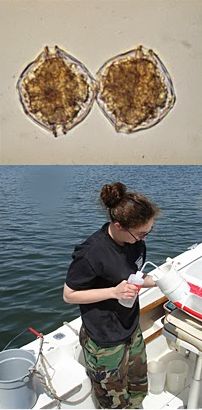 This week the state Department of Environmental Conservation closed 2,100 acres of Long Island’s North Shore to shellfish harvesting after Chris Gobler’s lab detected high concentration of the phytoplankton Alexandrium fundyense, a dinoflagellate which produces potentially deadly toxins. Clams, oysters, or mussels that feed on Alexandrium, accumulate the algae’s saxitoxins and can cause paralytic shellfish poisoning when ingested by humans.
This week the state Department of Environmental Conservation closed 2,100 acres of Long Island’s North Shore to shellfish harvesting after Chris Gobler’s lab detected high concentration of the phytoplankton Alexandrium fundyense, a dinoflagellate which produces potentially deadly toxins. Clams, oysters, or mussels that feed on Alexandrium, accumulate the algae’s saxitoxins and can cause paralytic shellfish poisoning when ingested by humans.
Gobler, an associate professor at Stony Brook Southampton whose research focuses on harmful algal blooms, began monitoring Alexandrium populations for the DEC in the winter of 2007.
“We know that typically these bloom happen first in the spring then again in the fall,” says Gobler, “In 2006, the Alexandrium event happened Memorial Day weekend. Last year’s smaller bloom was at the end of May. We were surprised when we went out towards the end of April and saw higher levels of Alexandrium than we had seen in all of 2007.”
Gobler suspects the early bloom was the result of warmer than usual April temperatures which caused the bays to warm up more quickly than last year.
Last year’s monitoring identified specific water temperatures (10-20 C) at which high concentrations of Alexandrium were likely to be present, “When we know the water is within the range of these blooms, we increase our sampling schedule to twice a week,” explains Gobler.
He and his students collect samples at about 30 locations on both the north and south shores of Long Island. They then apply an Alexandrium-specific fluorescent DNA probe. Since the probe only binds to the target species, it makes identifying and counting the Alexandrium cells easier than straight visual identification using light microscopy.
Gobler hopes to continue studying patterns of Alexandrium population growth. His lab is currently working to understand the relationship between bloom dynamics and nutrient availability. He adds it would also be useful to know how much of the bloom is driven by individual dinoflagellates emerging from the sediment where they have lain dormant as cysts and how much is controlled by population growth in the water column.
By providing weekly reports on Alexandrium abundance to the DEC, Gobler was able to alert the agency of possible shellfish toxicity, before anyone became ill. Once the DEC confirmed high levels of saxitoxins in local shellfish, they closed Northport Bay and Northport, Duck Island, and Centerport Harbors for shellfish harvesting.
Gobler hesitates to predict the outcome of the current Alexandrium bloom or the length of the DEC closures. “[The bloom] could be gone in 2 weeks, or I could see it staying the same or getting worse until it gets warmer—which may not be until June,” he says.
“This event demonstrates that phytoplankton monitoring is important for protecting human health,” says Gobler, “There’s a lag between the time we detect Alexandrium in the water, and appearance of toxicity in shellfish. That’s why monitoring is so effective.”
“When I heard about the closure, I rushed to congratulate Theresa Hattenrath, the graduate students who has done much of the work for this project, for potentially saving some people from getting sick.”



